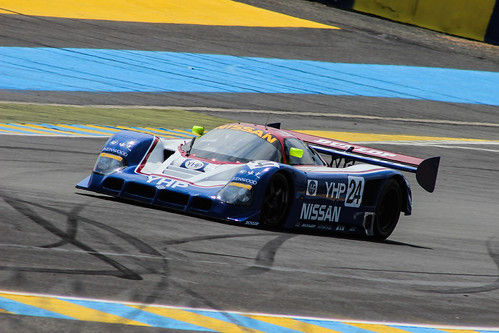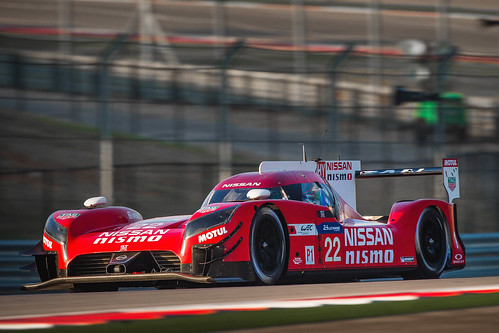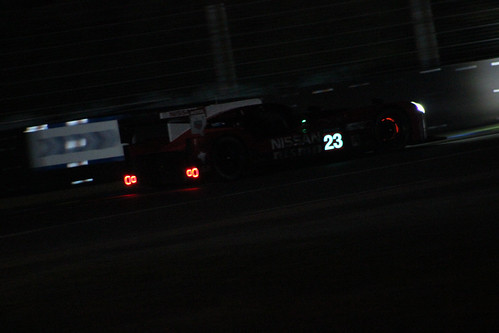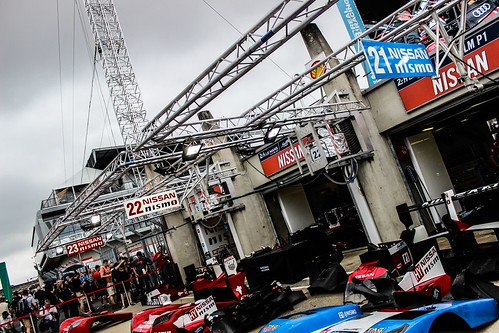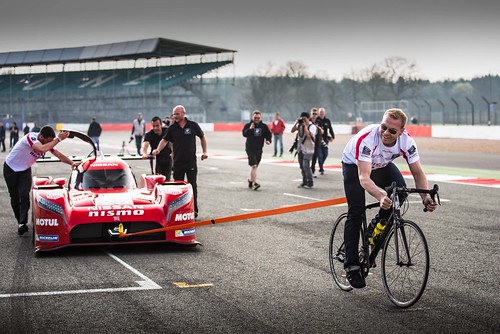Nissan were one of the most anticipated aspects of the 2015 FIA World Endurance Championship. With a radical design and big plans to take Le Mans and the World Championship, it seemed like a slow start would be inevitable, but lead to success in the end. They brought a brave concept to the championship, however we will never see it race again. We take a look at what lead up to the birth, the journey, and the demise, of the GTR-LM NISMO.
 The History: Nissan meets Le Mans
The History: Nissan meets Le Mans
Nissan are no strangers to the 24 Hours of Le Mans, after the beginning of the Group C regulations, Nissan began their pursuit of glory at Le Mans. However, it took until 1990 before the team had any success, although it was not to be in the race, but in qualifying. Mark Blundell took a famous pole position for the Japanese marque. Before Nissan could win, the Group C class came to an end, (their best finish was third in 1990). Their next chapter came in the late 90’s when a new R390 GT car took on Le Mans, but again, missed out to the likes of Porsche.
Nissan then left the challenge. However they returned slowly. They began supplying engines in 2005. Their supplier era started slowly. In 2005 Nissan supplied Rollcentre Racing with a 3.6L V8 Turbo engine that powered a Dallara SP1. The LMP1 car was driven by old faithful driver Michael Krumm alongside Harold Primat and Bobby Verdon-Roe. The effort was however ill-fated as it retired having completed 133 laps.
LMP2, Delta Wing and ZEOD: Faith in success at Le Sarthe builds
LMP2 finally brought success for Nissan at Le Mans in 2011 when their 4.5L V8 engine powered Greaves Motorsport’s Zytek to eighth overall and victory in class. 2012 followed with second, third and fourth place finishes in LMP2. 2012 also saw Nissan take a whole new approach to things at Le Mans, as the acquired the Garage 56 entry for innovative technologies.
The Nissan Delta Wing was the first race car from Nissan which earned them a reputation for pushing the limit of design. Ben Bowlby designed the Delta Wing based around the tub of the fellow ill-fated Aston Martin AMR-1. It showed much promise at Le Mans, with a qualifying time only 18 seconds off of the LMP1 pole time. Despite a race which ended on lap 75 at the Porsche Curves after contact with a Toyota, It’s lap times were fast enough within the race to mix with the pace of the LMP2 field, proving Bowlby and Nissan’s ability to pull off a radical design.
For 2013, Nissan did not leave off the LMP2 engine project, supplying the top 4 cars in class with their engines and then the top five in 2014. 2014 also saw Nissan return to Garage 56 with another bold idea. The ZEOD RC was a electrical hybrid car which was designed to run ideally on 100% electricity. The ZEOD managed to complete a whole lap of Le Mans entirely on electricity, and qualified ahead of the entire GTE field. The race however was a different story as it only managed five laps before it broke down due to a gearbox failure.

A New Chapter: LMP1 and the GTR-LM NISMO
However, before the ZEOD took on Le Mans, Nissan announced that they would step back up to the top class, with an LMP1 programme. And that was all they told us. Nissan were more than secretive over their project, only building the speculation over their new car. After the effort was officially announced on the 23rd of May 2014, testing got underway for the Japanese team, but very much in secret, the car was not seen in any colours or in any detail until the team’s Super Bowl advert revealed the GTR-LM NISMO to the world.

The car was again designed by Ben Bowlby, and followed in the foot steps of his previous bold designs. The GTR-LM NISMO was to have a front mounted engine and have a main front wheel drive system. It turned heads in the beginning, when speculation over a front wheel drive prototype race car with 1250bhp began to place doubt into the project. However, the confidence was booming at Nissan, with faith in their project.
According to Daily Sportscar.com, Andy Palmer, Nissan’s Executive Vice-President said “You don’t go to Le Mans to just turn up… The brief to the team is to go with something different, go with something that brings new technology which is transferable to the road car technology and an approach that is innovative and exciting and of course, go to win.”
Palmer added, “Believe me, I think this is the car that will go down in the annals of time and be one of those cars which will be long remembered, not only for the fact that it will have won Le Mans but also that it reset the real meaning of NISMO as a link between success on the track and success on the road.”

So it was made clear early on that Nissan were not just out to clone their way to victory. The team had faith in their radical interpretation of the rules. The faith was also shared by their drivers. Nine months after the project was announced. Marc Gene was the first driver to be uncovered before three days later, Olivier Pla, Harry Tincknell and Tsugio Matsuda, and this only made their statement bolder still.
Steeling a driver away from Audi in Marc Gene only confirmed that their was belief in the team behind the scenes. Oli Pla and Harry Tincknell, an experienced driver and a young gun both ready to make an impact in a step up to a manufacture LMP1 team, their big break. Alongside Nissan’s poster boy back in Japan, Matsuda. A driver that Nissan had the confidence in to step up from the national to the world stage.
 Michael Krumm, the main stay of the Nissan driver line up was then confirmed a few days later alongside the biggest statement yet. Jann Mardenborough and Lucas Ordonez, both victors of the Gran Turismo GT academy project saw the ex-gamers make it all the way to a LMP1 seat. Max Chilton and Alex Buncombe were the final two drivers confirmed, completing their nine driver Le Mans effort. Drivers promoted from within at Nissan, poached from rival teams and stolen from Formula One. This again, gave a little tingle that there was something about this Nissan project.
Michael Krumm, the main stay of the Nissan driver line up was then confirmed a few days later alongside the biggest statement yet. Jann Mardenborough and Lucas Ordonez, both victors of the Gran Turismo GT academy project saw the ex-gamers make it all the way to a LMP1 seat. Max Chilton and Alex Buncombe were the final two drivers confirmed, completing their nine driver Le Mans effort. Drivers promoted from within at Nissan, poached from rival teams and stolen from Formula One. This again, gave a little tingle that there was something about this Nissan project.
Reality check: Withdrawals and departures
Things seemed to be optimistic, yet confident at Nissan. It was clearly stated that this project would not be successful over night, however the reality of the project began to sink in before the World Endurance Championship got underway at Silverstone in April.
It was late on the 17th of March, under a month before lights out at Silverstone, that Nissan announced they would not be ready for the opening two rounds of the season, meaning they would debut at Le Mans. The rumored reason for the team dropping out of the first two rounds was because the GTR-LM was thought to have failed it’s crash test, although this was never confirmed.
Nissan however dealt with the announcement well. Nissan’s Global Head of Brand, Marketing and Sales, Darren Cox saying, “Our main aim for this year was always Le Mans and we have decided to re-focus on that race. He shared with AUTOSPORT that, “It’s no secret that with such a different car that we have faced a number of challenges, so right now we would rather be testing in April and May rather than racing.”
With all efforts being focused on Le Mans, the team had gained respect in the way that they were showing that they were taking Le Mans seriously. Testing continued at the Bowling Green circuit in the United States of America, and speculation rose as to how the new Nissan, billed as ‘The Beast’ would fare at Le Mans.
Le Mans test day came around and the worst was shown. With Nissan 27th, 29th and 30th fastest, at the back of the LMP2 field, and their slowest car just a second ahead of the fastest GTE machine.
However this was not before Marc Gene stepped away from driving duties, he left the driver line up leaving a spot for Mark Shulzhitskiy to become the first Russian LMP1 driver. However, was this a sign of a chink in the armor of Nissan? It is never a good sign when the most experienced driver (baring the loyal Krumm) no longer wants to be associated with driving the car.
Did the wheels come off at Le Mans?
No, although the suspension collapsed, but we’ll get to that. Nissan did make the start, however Jann Mardenborough started from the pit lane after early troubles, and they set the tone for the rest of the race. Engine failure and collapsed front suspension on the #21 retro liveried car saw the end of two of their efforts. However the #22 did make it to the finish, although to rub salt into the wound of Nissan, the car was unclassified because it failed to complete a certain number of laps. 242 laps were completed by the #22 GTR-LM NISMO.
Despite having none of their three cars as classified finishers, in the radical new cars first race, the one they had been focusing on, they had made the finish. No mean feat at Le Mans. Yes, the cars were off the pace, but interestingly the fastest down the straights, meaning there was something behind the GTR-LM which showed potential.
Le Mans was billed as a plausible success by Nissan, with BT’s website stating, “Nissan has celebrated success in the Le Mans 24-Hour race – even though its one surviving car finished plum last.”
After Le Mans, Darren Cox said, “I am feeling very proud of the whole team right now… For sure we have had problems but that’s what happens when you innovate.” He added, “Our engine is strong and we were able to quickly fix the other problems that we had. We have learnt an incredible amount at Le Mans and our battles will only make us stronger.”
“Most LMP1 manufacturers don’t finish Le Mans at their first attempt so it was important for us to hit this target,” Cox continued, “The guys in the garage are the heroes this weekend and the drivers have all done an incredible job, sometimes in very difficult circumstances.”
The Recovery: They’ll be back
Testing was continued, and it was then awaited to see how the future of their project would unfold. It seemed like a shaky beginning was starting to reward the team.
However, then came the news that Nissan would miss the Nurburgring 6 hour race, the next WEC event after Le Mans and that a decision on the rest of the season would be made at a later date, as development continued.
It seemed like the Nissan PR train, which certainly had no reliability issues at all, started to slow down after Le Mans. There was hope that the Japanese manufacture may make one more final appearance before the end of the season, however the news came on the first of October that Nissan would sit out the rest of the 2015 season, and that they were committed to getting it right in 2016.
Shoichi Miyatani, NISMO President spoke to DSC, saying, “We are committed to competing at the highest level and we are not happy when we are not winning,” He added, “Let’s not forget that while we have been pushing forward with the LMP1 challenge we have won the Blancpain Pro Cup Drivers title in Europe with the Nissan GT-R NISMO GT3 and are on target for another great year of success in GT500 in Japan. Racing is a vital part of our DNA and we will work to get this right.”
Darren Cox expanded, saying: “…we are now well placed to address the technical issues we have faced. We keep our sights firmly set on 2016 and we are confident…”
Via Nissan’s Flickr account, images of the tests continued, fueling onlookers with hope that the team were getting on top of their problems. New winglets were the most obvious development, as well as reports that a hybrid system would be in use come the 2016 season.
Before it falls to pieces: The final straw
It all seemed like Nissan would be back with a vengeance for the new season. However, Darren Cox, who had championed the project from the very beginning threw a curve ball into the mix when on October 30th, Cox announced he was to leave the Nissan-Renault Alliance manufacturer. Without Cox, who would drive the project?
Cox stated on leaving the team, “The decision to leave Nissan and the Alliance was not an easy one. I have enjoyed a great many years working on some amazing projects with great people and have thrived on the challenges, successes and even failures, in equal measure. I have seen GT Academy grow from a small European initiative to now embracing countries representing half the world’s population…”
The pendulum of ‘will Nissan sort this out or won’t they?’ took one final swing in the favor of the optimist when another test took place at the NOLA test facility in early December. New drivers such as the reigning Formula E champion, Nelson Piquet Jr were involved in the test, as part of looking to replace Olivier Pla, who is highly expected to take a seat at Ford in their GTE project for 2016.
However it all fell apart. On December 22nd 2015, Nissan announced they were to withdraw from the WEC, and cease the project that was the Nissan GTR-LM NISMO.
Nissan released this statement with the news. “Nissan entered LMP1 in the 2015 season with an innovative new, and bold concept, with the ambition to compete at the front of the field.
“The teams worked diligently to bring the vehicles up to the desired performance levels. However, the company concluded that the program would not be able to reach its ambitions and decided to focus on developing its longer term racing strategies.
“Racing is a core part of the Nissan DNA, and the company has a proud history of innovating to win. Nissan’s commitment to motorsports remains strong, as evidenced by its victorious track record in the 2015 season, from achieving the overall winner of Super GT two years in a row in Japan, to winning the Blancpain Endurance Pro Class, Bathurst 12hr race with the GT-R GT3. Nissan will continue its support of WEC through its various engine programs including recent introduction of LMP3 engine.”
The Bottom line: So who is to blame?
At this point it seems like Nissan have run from their responsibilities, but this is deceiving. In an interview of Daily Sportscar, Darren Cox said, “You mentioned earlier some pieces that mentioned a review of the programme – I think everyone should be surprised if there hadn’t been a review of a programme of this size. I know that Audi have a motorsport monthly review, we certainly, across all of Nissan’s activities, have a monthly review. Executives at Nissan are quite rightly very interested in this project so why wouldn’t they review it.”
This straight away gives an answer as to why the project was shut down so quickly. Although there is evidence to suggest it shouldn’t have been, it is a possibility that the higher up’s did not like the fact the team was not at the front, and slashed it.
This however is what does it for me, in the same interview the question, “So just how committed are Nissan to 2016?”, to which Cox answered, “We wouldn’t be continually developing and testing if this was some sort of swan song – This is about unlocking the potential of the package in the longer term”.
This interview was published on August 7th this year, just over four months before the project hit the red light. This again only proves that this project was shut down quickly and harshly.
But this is not just Nissan only being interested in winning. Cox also said during the DSC interview that “It’s easy to offer the opinion that we should have started in 2016 but the rules change at the end of ’16 and for any major company, building a motorsport programme for one year would not be the right thing to do so this year was the right thing to do, or wait until 2017, which was not what we wanted to do.”
Now, LMP1 hit record speeds in 2015. The Le Mans pole lap alone was in the region of 5 seconds faster than 2014. That forced the ACO and FIA to change the regulations for 2016, meaning the part were Cox states, “building a motorsport programme for one year would not be the right thing to do,,,” all of a sudden becomes all important. The unexpected rule changes meant that despite starting a year early to avoid a one year programme Nissan did exactly what they were trying to avoid.
If Nissan were to be around come the start of next season, their work on the 2015 spec GTR-LM NISMO would have been irrelevant, and with the rule change at the end of next season, the project would have again only been for one year (what they were trying to avoid) and therefore not worth it in their eyes.
For Nissan, once the confirmation came though it took one more test to see what could be salvaged for a potential new regulation 2016 effort, before the task was deemed too large, and ultimately shelved, leading to the abrupt ending of the project soon after the NOLA test.
The Verdict
As a first thought, it may not be surprising that Nissan will no longer race with the GTR-LM NISMO in the World Endurance Championship, after looking into how much time and planning had gone into next season, it did come as a surprise.
For me this is very much a case of ambition without support. The phrase, ‘if at first you don’t succeed, then try again’ is one that is evidently not in Nissan’s book, and that is a shame. Ben Bowlby designed a car capable of winning Le Mans, and a team of capable people and excellent drivers were put together. Unfortunate circumstances may have played a part, but a one year project rarely, baring Brawn GP’s 2009 F1 effort, ever brings success in an existing championship.
Nissan were only given one year, with a very short time to prepare. Audi did not look set for the dominance that was to come after their first Le Mans with their radical designs, and look where they have landed since. Bentley in the early 2000’s did the same. The only thing wrong with Nissan’s project was that the team did not have support for long enough to prove it could be a success.
It is a shame to see such a vibrant team with such an exciting car, which would have brought true innovation leave the paddock. All of us at WEC-Magazin hope to see Nissan back soon, and wish the team and the drivers’ all the best for the future.
Don’t forget to have your say at our Facebook page and in the comments below. Were Nissan too ambitious, or were they just unlucky?
Sources
Darren Cox quote (Postponing Season Start) – AUTOSPORT
Darren Cox on leaving Nissan – Daily Sportscar
Darren Cox interview from ‘The Bottom Line’ – Daily Sportscar
Darren Cox on Le Mans Success – BT
Cox and Miyatani looking forward to 2016 – Daily Sportscar
Images 1, 2, 4, 6, 11, 12, 13, 16, 17, 18 & 19 – James Clarke (WEC-Magazin)
Image 3 – Walter Schruff (WEC-Magazin)
Team Le Mans photo – Arstechnica.com
Testing Images – NISMO Global

